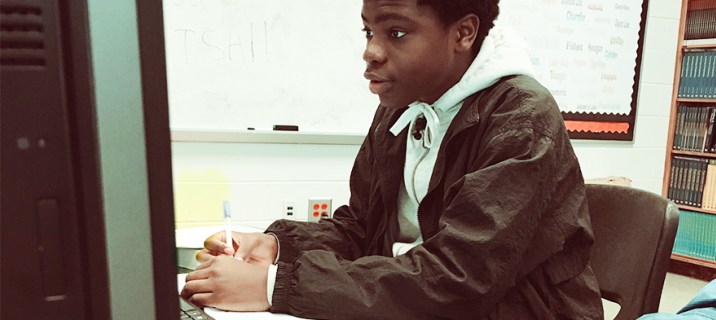The first round of parent teacher conferences recently wrapped up at my school in South Los Angeles. After the last parent left, I reflected on the students I serve, all of whom are students of color, and more than two-thirds come from socioeconomically disadvantaged families. During these conversations, I learned a mother of one of my students had selflessly taken in and cared for another student. I also learned that more of my students than I realized struggle with food insecurity. These tiny understandings I gained highlighted the fact that so many students face overwhelming challenges before they even walk into my classroom.
Too often, adults outside of my school write these students off. By the time they reach a middle school classroom, they’ve been fed a steady diet of negative platitudes about their worth and their academic ability. Many of them have attended failing schools since kindergarten and falsely think it’s they who fail and not the broken system that attempts to serve them. Data confirms the impact of these harsh words and inadequate instruction: by the time students from low-income communities reach eighth grade, they are on average three years behind their more affluent (and more often white) peers in math and reading.
My students struggle in school because they’ve been told intelligence is static, and no matter how hard you work, you were either born smart or “dumb.” I don’t believe in any of these myths, but my challenge is ensuring that my students come to reject them, too. While my students come to school facing obstacles I never experienced as a student, I know what we do in class can change their trajectory.
School isn’t just about mastering academic content. Teachers also have a prime opportunity to teach the power of hard work and perseverance. I systematically organize my class so that the person who works the hardest, not necessarily the “smartest” person in the class, will earn the best grade. Too often, classroom policies dictate that a student must display mastery of a subject by a certain time, and if they don’t, the opportunity is over, never to be revisited. By using a single test to set the parameters of learning, we limit student achievement.
In my classroom, opportunities to retake tests and redo assignments are infinite. If students are willing to put in effort to learn more, identify their misunderstandings, and ask for help, I’m willing to put in the effort to encourage and support them. My students are undoubtedly motivated by the opportunity to try again. I’ve seen students fail a first test with a score of 40 percent, study more, and ace the second. I’ve also seen an incredibly motivated student who earned a 92 percent on a test study many more hours so they can earn those few extra points. This is the drive I want my students to cultivate in my classroom. While this strategy requires that I make many versions of a test and forces me to think creatively about how to assess mastery multiple times, my students deserve the opportunity to show their perseverance and knowledge.
I’m driven to do this because I have seen how successful it can be.
One of my former students, Jaiden, had a terrible temper and couldn’t take two steps into my classroom without fighting with other students. When the first set of report cards came out, Jaiden was only earning a 30 percent—clearly not enough to pass any class. He was known for his athletic ability, which, in his opinion, was the only reason he came to school and the only way he earned acknowledgment. I needed to show him that there was also value in working hard off the field.
Every Monday, I celebrated students who scored 80 percent or higher on the previous week’s many assignments by playing music and starting an over-the-top celebration of those students’ hard work, especially if they had to do the assignment multiple times in order to master it. Something changed in Jaiden after watching those celebrations. A fire started inside him, and he started working harder. This earned him recognition in class, spurring him to work even more. After a rough start to the semester, his questions changed from, “Did I get the best grade?” to statements like “I had to take that assignment 5 times to get a 100.”
That is when I knew this methodology worked. Jaiden needed to see that if he was willing to put in the work, I wouldn’t put a limit on his success. Jaiden is in high school now and doing well. His success is a testament to what students can accomplish when extended the opportunity of high expectations and boundless learning.
This approach is just one way in which I seek to meet my students where they are. As I learn more about my students via parent conferences or observing them in class, I will adapt my instructional strategies to ensure all of my students are able to learn and achieve daily. When this school year ends, I have two goals: my students will have understood the value of perseverance in my class and that their next classrooms will be structured in a way that continues to push them to develop grit, value practice, and pursue achievement for the rest of their lives.
Originally posted in Education Post
Tunji Adebayo
Latest posts by Tunji Adebayo (see all)
- I Don’t Want the Smartest Kid, I Want the Hardest Working One - November 21, 2016
- No Quiero el Estudiante Más Inteligente, Quiero el Más Trabajador - November 21, 2016

